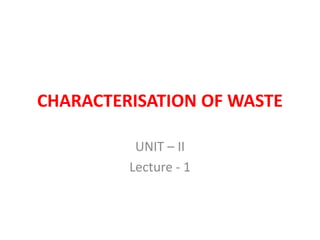
CHARACTERISATION OF WASTE.pptx
- 1. CHARACTERISATION OF WASTE UNIT – II Lecture - 1
- 2. UNIT 2 • Waste characterization • Waste disposal on land • Site selection • Leachate and Gas Generation • Waste containment principles • Contact hours: 08 hours
- 3. SOLID WASTE • Solid in state (may also be liquid or gaseous but stored/contained in a container) • The refused material which has no further use • Waste can be characterized on the basis of 1. TYPE OF WASTE 2. SOURCE OF WASTE 3. QUANTITY OF WASTE 4. COMPOSITION OF WASTE
- 4. BASED ON TYPE OF WASTE • Discard: Can be used after treatment (Plastic and glass bottles, newspaper, metal) • Garbage: biodegradable fraction (food waste) • Rubbish: waste excluding garbage • Trash: Inert fraction of waste (glass/metal) • Combustibles: waste which can be burnt easily (paper, packaging material, wood etc.)
- 5. SOURCE OF WASTE • Domestic (food waste, ash, earth, paper, polythene) • Commercial (paper, polythene, packaging material, glass, metal) • Agricultural (plant based waste) • Industrial (sludge, ash, slag etc.) • Construction & Demolition (masonry, sand etc.) • Automobile (discarded vehicles)
- 7. COMPOSITION OF WASTE • Material Flow Methodology • Direct Field study 1. Collect samples from source 2. Collect samples from treatment facility • Samples should be representative; sufficient in number; and precise • ASTM D 5231: defined protocol for sample collection • Grab sampling; Composite sampling; Coning and Quartering; Column sampling are different types of sampling methods
- 9. ANALYSIS OF SAMPLES PROXIMATE ANALYSIS • Moisture Content (%):Heat at 105˚C for 1 hour • Volatile Organic Carbon (%): Heat at 950˚C for 10 minutes in the absence of oxygen • Ash Content (%): Heat at 950˚C for 10 minutes in the presence of oxygen • Fixed Carbon (%) = 100 – MC – VOC – AC
- 11. ANALYSIS OF SAMPLES ULTIMATE ANALYSIS • Moisture Content (%):Heat at 105˚C for 1 hour • Ash Content (%): Heat at 950˚C for 10 minutes in the presence of oxygen • Elemental Analyis (%) for C, H, N, S, O, Cl, P For waste from natural origin • Carbon ≥ 6*Hydrogen; • Oxygen > 30%; • Nitrogen/Sulphur/Chlorine < 1%
- 13. 31 March 2023 FDP on Environmental Geotechnology, SBSSTC, Ferozepur, Punjab 13
- 15. 31 March 2023 15